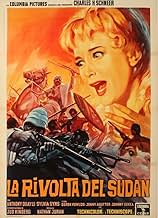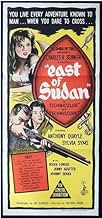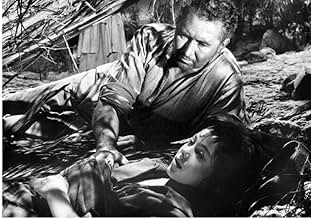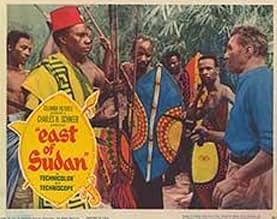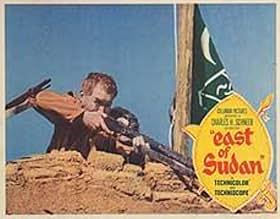NOTE IMDb
5,1/10
312
MA NOTE
Ajouter une intrigue dans votre langueIn late 1884, during the height of the Mahdist insurrection, Khartoum is under siege. An English trooper awaiting court martial leads a British governess, her native charge, and a stuffy you... Tout lireIn late 1884, during the height of the Mahdist insurrection, Khartoum is under siege. An English trooper awaiting court martial leads a British governess, her native charge, and a stuffy young officer down the Nile to safety.In late 1884, during the height of the Mahdist insurrection, Khartoum is under siege. An English trooper awaiting court martial leads a British governess, her native charge, and a stuffy young officer down the Nile to safety.
Ilario Bisi-Pedro
- Witch Doctor
- (non crédité)
Derek Blomfield
- Second Major
- (non crédité)
Harold Coyne
- Maj. Harris
- (non crédité)
Desmond Davies
- Aide
- (non crédité)
Edward Ellis
- Arab
- (non crédité)
Joseph Layode
- Gondoko
- (non crédité)
Avis à la une
EoS has been screened several times recently on British TV and the synopsis seemed promising. It turned out to be a mix of "Ice Cold in Alex" (Anthony Quayle and Sylvia Syms escaping from a beleaguered town), "North West Frontier" (heroic Brit, governess and child escaping from a beleaguered town), "The Four Feathers" (much stock footage) and several travelogues (stock footage of various animals and native dancing).
Other reviewers here on IMDb have already commented on the amateurish mixing in of the footage of charging animals. I am resigned to the heroine in films of this vintage apparently having access to make-up and hairdressing facilities as she undergoes various privations, Miss Woodville continuing to look glamorous at the end. And Murchison's rapidly falling in love with Miss Woodville is par for the course, though usually in films such relationships develop into a three-way romance with rivalry between the two men. In EoS his passion seems to have fizzled out as quickly as it appeared.
But there were at least three risible scenes. The first was when, after Baker had rued the small stock of ammunition, Murchison fires his revolver several times in enemy country to stampede a herd of animals to delight Asua. Then he sets off the signal fire when he sees a boat on the Nile. Not even the most callow officer would be so stupid. Thirdly, when the fugitives are hiding from the slavers they are barely concealed by a few fronds of foliage; they are fully visible to the camera - and thus to the men searching for them inches away who do not notice them.
One might also think Baker very well-spoken for a private soldier who had been demoted from sergeant several times, but, as other films ("Beau Geste", "Under Two Flags") have shown, "gentleman-rankers" did exist.
Other reviewers here on IMDb have already commented on the amateurish mixing in of the footage of charging animals. I am resigned to the heroine in films of this vintage apparently having access to make-up and hairdressing facilities as she undergoes various privations, Miss Woodville continuing to look glamorous at the end. And Murchison's rapidly falling in love with Miss Woodville is par for the course, though usually in films such relationships develop into a three-way romance with rivalry between the two men. In EoS his passion seems to have fizzled out as quickly as it appeared.
But there were at least three risible scenes. The first was when, after Baker had rued the small stock of ammunition, Murchison fires his revolver several times in enemy country to stampede a herd of animals to delight Asua. Then he sets off the signal fire when he sees a boat on the Nile. Not even the most callow officer would be so stupid. Thirdly, when the fugitives are hiding from the slavers they are barely concealed by a few fronds of foliage; they are fully visible to the camera - and thus to the men searching for them inches away who do not notice them.
One might also think Baker very well-spoken for a private soldier who had been demoted from sergeant several times, but, as other films ("Beau Geste", "Under Two Flags") have shown, "gentleman-rankers" did exist.
A very poor man's 'African Queen' that must have seemed old-fashioned in it's patronising treatment of the natives even when it was originally made. Dashed off in three weeks at Shepperton by producer Charles Schneer and director Nathan Juran for the bottom half of a double bill with their main feature 'First Men in the Moon', it has the vices of Schneer's films with Ray Harryhausen enumerated by the late Bill Warren as "underfinancing, pandering to the 'appropriate' audience, a slightly cheesy air" all present and correct (plus a truly awful score by Laurie Johnson) without the redeeming input by Harryhausen himself.
Fortunately, more by luck than judgement Schneer has gathered together an extremely attractive quartet of actors, including an unrecognisable 11 year-old Jenny Agutter as a blue-eyed Indian princess (initially taken for a boy by Anthony Quayle when he first meets her), while director Juran keeps the camera on the move during the hilarious studio exteriors that resemble something out of 'Ripping Yarns' on to which they have been corralled and into which colour footage has been spliced from 'The Four Feathers' and various fifties jungle pictures.
Fortunately, more by luck than judgement Schneer has gathered together an extremely attractive quartet of actors, including an unrecognisable 11 year-old Jenny Agutter as a blue-eyed Indian princess (initially taken for a boy by Anthony Quayle when he first meets her), while director Juran keeps the camera on the move during the hilarious studio exteriors that resemble something out of 'Ripping Yarns' on to which they have been corralled and into which colour footage has been spliced from 'The Four Feathers' and various fifties jungle pictures.
I do not recall seeing a film which derives not only background shots but most of its action from stock shots and parts of another feature,including the climax.So virtually all of the action comes from The Four Feathers(1938)This film looks as if it has been made on a shoestring.For example there are shots of charging elephants and you have the actors shooting at them from in front of a process screen.It is so clear that they have not been anywhere near the Sudan.At the climax you have Anthony Quayle on a small set on the left of frame with the main action fromThe Four Feathers either put in by a process screen or an optical printer.The acting is not up to much ,the only exception being the dependable Anthony Quayle.So all told rather a disappointment.
East of Sudan is a simple adventure movie from 1964, depicting the fall of Khartoum but without any actual falling that the viewer can discern. That's because we are only informed of it, that General Gordon is defeated and his head is displayed on a spike. Don't worry, we don't see any of that.
What footage of the battles are obviously lifted from other films as this entire production was shot in the studio. Clips of wild animals are used with back projection, allowing actors to stand in front of a screen and shoot at them or wave their arms about, amusingly I might add, it's so ineptly directed.
I thought about giving this one star but raised it to three because, strangely I enjoyed some of it. For a start there is the gorgeous Sylvia Syms at the height of her fame, that fine actor Anthony Quale who does his best with an atrocious script, Derek Fowlds who I know people remember fondly from Yes Minister on TV and little Jenny Agutter looking about ten years old but just as pretty as when she grew up, even though she's hopelessly miscast as an Indian princess with a black wig. Unfortunately her skin is white as Snow White.
It kept me watching in spite of it's flaws and making me wince from time to time as it zips along at fairly brisk pace. Children who wouldn't notice these bloopers might well enjoy it so I mustn't be too harsh although I did feel a bit sorry for Anthony Quale who deserved better material.
OK to watch with a young family on a Sunday afternoon.
What footage of the battles are obviously lifted from other films as this entire production was shot in the studio. Clips of wild animals are used with back projection, allowing actors to stand in front of a screen and shoot at them or wave their arms about, amusingly I might add, it's so ineptly directed.
I thought about giving this one star but raised it to three because, strangely I enjoyed some of it. For a start there is the gorgeous Sylvia Syms at the height of her fame, that fine actor Anthony Quale who does his best with an atrocious script, Derek Fowlds who I know people remember fondly from Yes Minister on TV and little Jenny Agutter looking about ten years old but just as pretty as when she grew up, even though she's hopelessly miscast as an Indian princess with a black wig. Unfortunately her skin is white as Snow White.
It kept me watching in spite of it's flaws and making me wince from time to time as it zips along at fairly brisk pace. Children who wouldn't notice these bloopers might well enjoy it so I mustn't be too harsh although I did feel a bit sorry for Anthony Quale who deserved better material.
OK to watch with a young family on a Sunday afternoon.
Derring-do in the desert, re-teaming Anthony Quale and Sylvia Sims, who previously appeared together trekking across the desert in "Ice Cold in Alex" (1958). Along for the ride are Derek Fowlds (from "Yes Minister") and a young Jenny Agutter, whom viewers may remember from "Logan's Run" (1976). This time, however, instead of trying to stay one jump ahead of "Jerry" in the Western Desert, Tony and Sylvie are on the run from Dervishes, Arab slavers and Fuzzy-Wuzzies in 1880's Sudan.
Most of the action sequences are lifted straight out of the 1939 film version of "The Four Feathers." However, that is not a bad thing, since "The Four Feathers" was one of the greatest action-adventure films ever produced and, unlike the dreadful 2002 remake, actually was filmed entirely on location in the Sudan, something which would be impossible today.
Anthony Quale plays an experienced British "Squaddie" trying to escape to Khartoum after his entire unit has gotten the chop. En route he falls in with a green young Lieutenant (Fowlds) along with a prudish British governess (Sims) and her Egyptian charge played by young Jenny Agutter in her first film role. Quale quickly demonstrates that he is the only one of the mismatched group who is able to distinguish his sphincter from his medial brachial joint. However, his principal difficulty is in persuading his upper-class companions to accept the leadership of a mere "prole". This film may not quite be up to the quality of "The Four Feathers", nor even of "Ice Cold in Alex", but it is an entertaining journey nonetheless.
Most of the action sequences are lifted straight out of the 1939 film version of "The Four Feathers." However, that is not a bad thing, since "The Four Feathers" was one of the greatest action-adventure films ever produced and, unlike the dreadful 2002 remake, actually was filmed entirely on location in the Sudan, something which would be impossible today.
Anthony Quale plays an experienced British "Squaddie" trying to escape to Khartoum after his entire unit has gotten the chop. En route he falls in with a green young Lieutenant (Fowlds) along with a prudish British governess (Sims) and her Egyptian charge played by young Jenny Agutter in her first film role. Quale quickly demonstrates that he is the only one of the mismatched group who is able to distinguish his sphincter from his medial brachial joint. However, his principal difficulty is in persuading his upper-class companions to accept the leadership of a mere "prole". This film may not quite be up to the quality of "The Four Feathers", nor even of "Ice Cold in Alex", but it is an entertaining journey nonetheless.
Le saviez-vous
- AnecdotesTheatrical movie debut of Jenny Agutter (Asua).
- GaffesThe end of the film heavily implies that the two-day-late relief force for General Gordon recaptures Khartoum. In reality, the relief force discovered the city already taken and the Mahdist forces strong, and were forced to retreat, leaving Sudan to the Mahdi. Khartoum was retaken only 13 years later in 1898.
- ConnexionsFeatures Les quatre plumes blanches (1939)
Meilleurs choix
Connectez-vous pour évaluer et suivre la liste de favoris afin de recevoir des recommandations personnalisées
- How long is East of Sudan?Alimenté par Alexa
Détails
- Durée1 heure 25 minutes
- Rapport de forme
- 2.35 : 1
Contribuer à cette page
Suggérer une modification ou ajouter du contenu manquant



